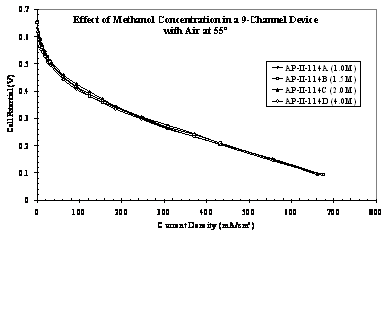Marokoski et. al. and others1-5 have demonstated the concept of Laminar Flow Fuel Cells (LFFC) using single channel microfluidic devices. In general these electrochemical cells consist of two catalytic electrodes separated by an insulating channel through which flows fuel (eg. H2, methanol, formic acid, redox fuel) and oxidant (e.g. O2, KMnO4, Vanadium) dissolved in an electrolyte solution (e.g. H2SO4, KOH). A laminar flow boundary is established whereby the fuel and oxidant streams flow side-by-side against their respective electrodes in the absence of convective mixing (cross-over) while maintaining ionic contact at the liquid/liquid interface where the circuit is completed by diffusion alone. Through subsequent research this academically interesting concept was further developed to demonstrate commercial viability as portable power devices. Issues like achieving high current/power density, fluid splitting and recycling for enhanced fuel utilization, utilizing commercially viable oxidants (air breathing) etc. were addressed by incorporating a microporous separator between the two streams2 and integrating a gas diffusion electrode and gas channels behind the cathode3. As a next step, multi channel devices were designed to demonstrate the scalability in the X (# of channels) Y (channel length) and Z (multi-cell stack) dimensions. This scalability analysis was conducted keeping in mind the parasitic pumping constraints that translate into maximum pressure drop limitations on both the liquid (< 5 psi) and gas (< 1 psi) sides. A sample performance curve obtained using one particular cell design (9 channel, single cell) is provided in Figure 1 to show that LFFC performance can equal (with potential to greatly exceed upon system optimization) that of state-of-art DMFCs under identical conditions. Another key criterion for LFFCs to be competitive in the portable power market is enhanced fuel utilization by minimizing parasitic fuel losses due to methanol crossover to the cathode, which is one of the major drawbacks of DMFC. We adopted a three-pronged approach to address this problem. First, we developed anode catalyst layers that can sustain high performance even at relatively low fuel concentrations without concentration polarization losses. This allows us to mitigate crossover by minimizing the driving force behind fuel crossover namely concentration gradient. Next we manipulated the properties of the microporous separator between the two streams such that the effective diffusion coefficient of methanol was significantly reduced while maintaining proton conductivity. Finally, we have developed selective barrier layers at the cathode that minimize the cathode's ability to oxidize the fuel crossing over. With this approach we have managed to reduce methanol crossover by more than an order of magnitude bringing us one step closer to commercialization. Based on the research conducted so far we are currently building a 20 W LFFC stack/system prototype that would prove to be the test platform to identify the ideal operational window for our future products.
1. Markoski, L.J.; Moore, J.S.; Lyding, J. U.S. Patent 6,713,206, 2004 2. Choban, E.R.; Markoski, L.J.; Wieckowski, A.; Kenis, P.J.A. J. Power Sources, 2004, 128, 54-60 3. Ferrigno, R.; Stroock, A.D.; Clark, T.D.; Mayer, M.; Whitesides, G.M. Journal of the American Chemical Society 2002, 124, 12930 4. Cohen, J.L.; Westly, D.A.; Pechenik, A.; Abruna, H.D. J. Power Sources 2005, 139, 96 5. Mitrovski, S.M.; Elliott, L.C.C.; Nuzzo, R.G. Langmuir 2004, 20, 6974 6. Primak, A.; Kenis, P.J.A; Markoski, L.J; “ Improved Performance of Direct Methanol Laminar Flow Fuel Cells,” 207th ECS Meeting, Quebec City, Canada, May 15-20, 2005 7. Jayashree, R.S.; Gancs, L.; Choban, E.R.; Primak, A.; Natarajan, D.; Markoski, L.J.; Kenis, P.J.A, Journal of the American Chemical Society 2005, 127, 16758
Figure 1: I/V performance (3 minute steps) of multi-channel dual liquid and air-breathing (3 stoich 0psig) LFFC utilizing 1-4M MeOH as fuel and 1M H2SO4 as electrolyte at 55°C

